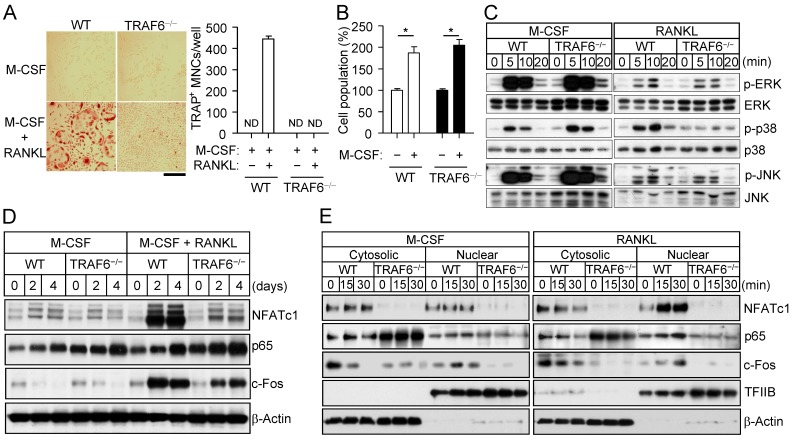Figure 5.
TRAF6-dependent activation of p38 by RANKL. (A) Osteoclast precursors from wild-type (WT) or TRAF6-/- mice were cultured in the presence of M-CSF (30 ng/mL) either alone or together with RANKL (100 ng/mL) for 4 days, after which the proportion of TRAP+ MNCs was determined. Data are means ± SD for three independent experiments. ND, none detected. Representative images of the stained cells are also shown. Scale bar, 100 µm. (B) Osteoclast precursors from WT or TRAF6-/- mice were incubated with or without M-CSF (30 ng/mL) for 2 days, after which the number of cells was counted. Data are expressed as a percentage of the corresponding control value and are means ± SD (n = 3) for three independent experiments. *P < 0.01 (Student t test). (C) Osteoclast precursors from WT or TRAF6-/- mice were incubated with M-CSF (25 ng/mL) or RANKL (500 ng/mL) for the indicated times, after which cell lysates were subjected to immunoblot analysis of MAPK activation. Data are representative of three independent experiments. (D) Osteoclast precursors from WT or TRAF6-/- mice were incubated with M-CSF (30 ng/mL) alone or together with RANKL (100 ng/mL) for the indicated times, after which cell lysates were subjected to immunoblot analysis of NFATc1, p65, and c-Fos. Data are representative of three independent experiments. (E) Osteoclast precursors from WT or TRAF6-/- mice were incubated with M-CSF (30 ng/mL) and RANKL (100 ng/mL) for 2 days (to allow the formation of TRAP+ mononuclear cells), deprived of M-CSF and RANKL for 6 h, and then stimulated with M-CSF (25 ng/mL) or RANKL (500 ng/mL) for the indicated times. Cytosolic and nuclear fractions were then prepared from the cells and subjected to immunoblot analysis of NFATc1, p65, and c-Fos. β-Actin and TFIIB were examined as loading controls. The gel images for C, D, and E are representative of three independent experiments.

